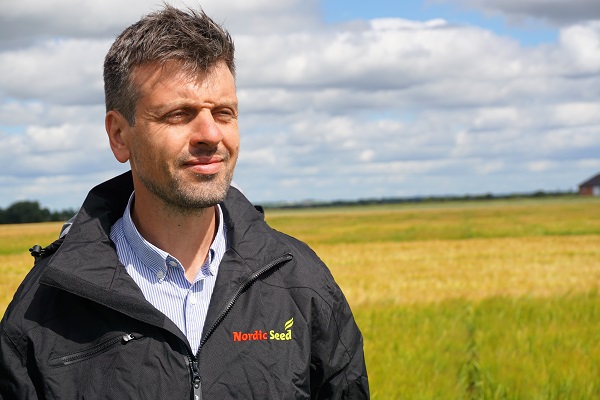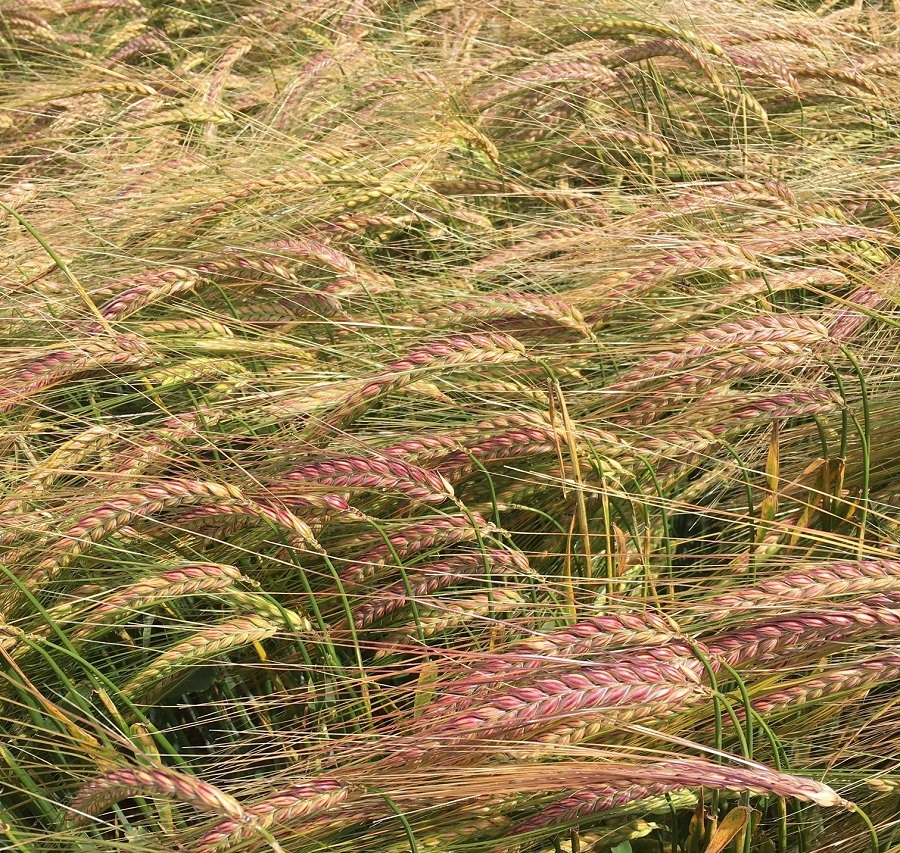As advances in breeding accelerate the yield potential of conventional barley varieties, a new offering from Senova looks to be hot on the heels of some of the top hybrids. CPM reviews Bordeaux.
Varieties like Bordeaux are closing the yield gap between conventional and hybrids.
By Charlotte Cunningham
For those looking to achieve high barley yields, hybrid varieties have perhaps naturally been an attractive choice.
However, developments in breeding mean that many conventional varieties are now closing the gap on this yield disparity – increasing options and flexibility for growers.
And among those is Senova’s latest two-row feed variety – Bordeaux – which boasts the tagline ‘a two-row feed with six-row yields’.

Bordeaux is the product of one of the first crosses from the Nordic Seed breeding programme which commenced in 2011, says Jens Due Jensen.
Bordeaux is the product of a KWS Glacier x Padura cross, with Padura coming from Danish breeders, Sejet, explains Jens Due Jensen, head of barley breeding at Nordic Seed. “Nordic Seed didn’t have a winter barley breeding programme until 2011 and Bordeaux has actually come out of one of the first few crosses from the newly established programme.”
The programme started in a very modest way, with Nordic looking to the Danish Farmer Union trials (which are comparable with the UK’s Recommended List trials) to seek out high yielding varieties with robust traits for crossing and it was KWS Glacier and Padura that stood out as good potential parents for what would eventually become Bordeaux, he explains.
“You hope that you’ll get something commercially viable from a cross, but the truth is, you can never really predict how good it will be – even with all of the modern technology – because what is inherited from each parent is effectively out of our hands. However, with Bordeaux, we have been able to combine the best from both parents in a package that offers some really good potential to growers.
“For example, Glacier benefits from BaYMV resistance but Padura doesn’t, however, its progeny does.
“Also from Glacier, Bordeaux has inherited a good specific weight, while low screenings are a trait brought across from Padura.”
Delving deeper into those traits, Bordeaux rivals the six-row hybrids yield wise, joining the list on 106%, says Jeremy Taylor, commercial director at Senova. “As well as this, with a specific weight of 69.9kg/hl and low screenings losses, Bordeaux also offers better grain quality than most other winter barleys, along with early maturity.”
And much like Bordeaux is well known for its wine production, Bordeaux the variety is easily identifiable in the field thanks to its striking red awns.
In terms of agronomics, it comes in at a height of 86cm and boasts a score of 7 for lodging resistance. “It’s also resistant to Barley Yellow Mosaic Virus and has ratings of 6 for both mildew and brown rust,” adds Jeremy.
It does, however, find itself at the lower end of the scale with its rhynchosporium and net blotch ratings. While Jens says they would have preferred to see higher scores, Jeremy says in private trials there hasn’t been any obvious issues with either disease.
Despite the lower scores, Jeremy believes that Bordeaux could be an incredibly low risk option for growers looking for something new this season. “It’s a crop that is early to harvest and makes for an attractive entry into oilseed rape. As well as this, it has been very consistent – something we know is increasingly important for growers.
“In the difficult 2020 growing year, Bordeaux still produced the goods,” he adds. “There are commercial reasons why conventional barley varieties are preferred to hybrids on-farm, and with varieties like Bordeaux closing the yield gap between them, there are now compelling agronomic reasons too.”
Despite spending a large chunk of its early life under water, Bordeaux has proved to be a good choice for Fife-grower, David Bell, who saw his 4ha crop win a gold YEN award last year.
Despite an extremely challenging year, the 4ha field of Bordeaux produced 11.9t/ha at harvest, beating some of the UK’s best wheat crops.
Calculated as having a potential yield of 14.1t/ha, the same field also produced the highest margin on Upper Magus Farm, St Andrews, at just over £1300/ha excluding operations.
“It’s great to get good yields, but we also need to make money,” says David. “That means we don’t chase yield at any cost, and we always consider its potential first.”
For David, national recognition comes after a concerted effort to improve the average yield of every variety grown, using the shared learning and knowledge exchange that the ADAS initiative provides.
“The learning is great, as it never stops, but taking part in YEN is financially motivated as well,” he adds “The benefit is to the business, as well as the crops.”
Having seen the yield potential of Bordeaux while it was still a candidate, David was keen to compare it to his existing choices, especially as it appeared to offer better grain quality. When the opportunity to secure some seed came along, he jumped at the chance.
“As a mixed farmer, I am always on the lookout for conventional two-row barley varieties that offer good specific weight and palatability as well as high yields. From the limited information available at the time, Bordeaux seemed to do that.”
David drilled it right at the beginning of Oct at 400 seeds/m², using a plough and power harrow combination, before rolling it and applying a pre-emergence herbicide. The field had been earmarked for a YEN entry, with the crop following peas and establishing well in good conditions, he says.
But despite a good start, the weather then took a turn for the worse, recalls David. “It started raining and it didn’t stop. Even with our very resilient soils, there was waterlogging – with some of the field of Bordeaux being under water for a week.”
The crop survived, which he believes was partly due to the business focus on improving the soils and getting them to function well. “With plenty of FYM use, high organic matter content helps with water management as well as nutrient cycling.”
No autumn insecticides were used, as aphid thresholds weren’t reached and IPM practices are an integral part of the farm routine. “A flower margin around the field helps provide habitat and food for beneficial insects, while monitoring of pests allows informed decision making.
“BYDV can be a problem, but there are a number of variables with it, which is why IPM is so important. We try not to use insecticides wherever possible, he adds.
When it comes to disease control, David works closely with his agronomist Iain Anderson to decide on the best course of action and the fungicide programme used on the Bordeaux crop came to just over £78/ha and consisted of four sprays, timed to coincide with key development stages.
As a new variety, the data on Bordeaux was scarce, he reports. “We knew that it was more susceptible to rhynchosporium than the other diseases, so we were able to plan for that. Of course, once the weather dried up in the spring, disease pressure was low.”
He points out that there are still plenty of actives for use in barley, whatever the disease challenges.
“Growing a variety very early on in its commercial life it gives us the chance to learn about its strengths and any weaknesses.”
David believes that keeping the crop clean through its early growth stages maximised the chances of not losing valuable leaf area, while a split dose PGR programme helped as the barley was being pushed. “A ‘little and often’ nutrition programme, with the aim of not stressing the plant and keeping it healthy, was also important.
“It had five fertiliser applications, with the first going on ahead of drilling, and a trace element foliar feed was added when fungicides were applied. Biostimulants were also used, to help the crop cope with the very dry spring period.”
As a result, it kept growing and remained healthy, with harvest taking place on 8 August, following the decision not to desiccate it, he adds.
David is growing Bordeaux again this year and intends making another YEN entry with it. With three fields in the ground, he is also transitioning to reduced tillage/no-till for his cereal crops, so has used his new drill to establish them.
“Our soils are in good condition with plenty of microbial activity, so it’s the right time to try new techniques and look at their contribution to reducing the farm’s carbon footprint. Bordeaux’s very high yields mean that its footprint will be very low.”
Trade talk
So it looks good in the field and growers are impressed – but how does the trade reckon Bordeaux will fare in a competitive marketplace?
“Being a new variety, we don’t have an awful lot of experience with Bordeaux yet, but all the numbers stack up and look very promising,” says Christian Maltby of Bartholomews. “The seed crops we’ve got out are looking very good too.”
Perhaps unsurprisingly, the standout feature for Christian is Bordeaux’s high yields. “Bordeaux also has a good strong agronomic package and combined with a very high yield potential means for us, and our growers, we can see that this would be a very strong contender in the marketplace and will keep the hybrids on their toes.”
So far, Christian says there are no obvious weaknesses and growers should be able to get good results with just a standard control programme.
In terms of location, Bordeaux can be grown fairly universally, adding to that flexibility for growers, he points out. “If you’re a winter barley grower and want to be aiming for those top yields, then this is the variety to look at.”
When it comes to market share Christian says that current pricing indicates good potential for winter barley. “Thinking about Bordeaux specifically, we can’t see why it won’t sell out this year. With high yields, it really is snapping at the heels of hybrids and breeding is progressing rapidly which means there’s some really healthy competition in the sector.”
For GO Davies’ Owain Roberts, Bordeaux’s combination of good yields and high specific weight is likely to draw interest from growers in that region. “In the West, we’re looking at yields of 102% and with a specific weight of 69.9kg/hl, I think Bordeaux will be a very attractive option for growers in here.”
With regards to rhynchosporium and net blotch, Owain says he’s confident this can be dealt with through a robust programme, and it shouldn’t deter growers as Bordeaux is a real step up for feed barley growers in the West. “What’s more, the fact it is a good, short-strawed stiff variety just opens up that flexibility for growers – what’s not to like?”
Bordeaux at a glance

Source: AHDB Recommended List, Winter barley 2021/22 [ ] = limited data




